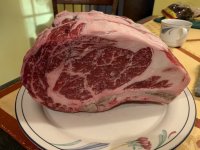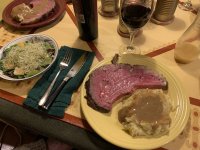I guess it all depends on your definition of "sear". It's still a sear in my book as even in a hot oven (or a hot 375-425) it will develop the "crust" or the Maillard reaction. And look, I'm just telling you how I would treat a $100+ piece of meat. Nothing more. And after falling for the "oh you gotta have it rocket fuel hot thing and ruining a couple of what could have been wonderful dinners, I have stopped falling for that "stuff". Since then, I have not ruined or had a bad tasting roast in many years UNLESS I had been distracted by kids (easy to do with toddlers under foot at times though I would rather have them helping ruin something than not have them

) or some type of other "issue" going on.
Your grill is easy enough to use just like a "hot oven" which is how I use(d) my gas grill(s). (I only have one "real" gas grill now being my Wolf as my Genesis went to the big cookout in the sky.
I know my brother is one who likes to do the really high heat thing on his prime ribs and he just swears by it. But, quite honestly I dread eating his rib roasts as all I taste is "sear" (or IMHO "carbon") for days afterwards.
I pay too much for beef to do that to it and being retired it's fixed income for us. I work very hard to develop a nice "crust" on it, with an edge to edge medium rare, and only the taste of good beef and some smoke. I don't add garlic, or other strong flavors either. Just good ol S&P.
And, it's advice based on my opinion of a good roast. Yours may vary. So, take my tips or don't. We'll still be friends.


